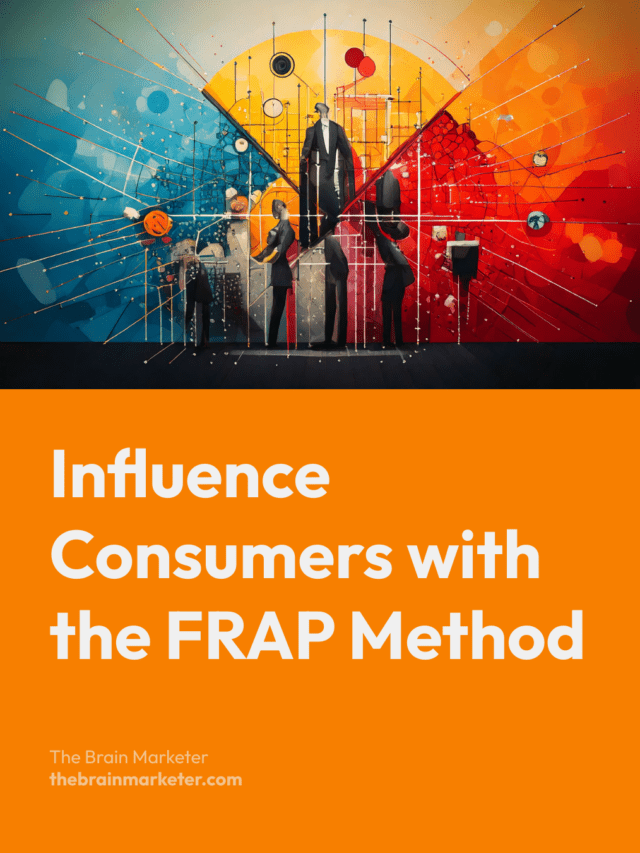In today’s hyper-competitive market, even the best products struggle to succeed without a deep understanding of how consumers think and decide. The F.R.A.P method (in French: Frustrations, Revendications, Apport, Pulsion; translated as Frustrations, Claims, Contribution, Impulse) is a strategic framework grounded in neuromarketing principles. Its purpose is to help marketers craft messages that resonate deeply and drive action.
Key Takeaways
- The reptilian brain drives decisions, design messages that speak to it.
- Use the F.R.A.P method (Frustrations, Revendications, Apport, Pulsion) to build trust and urgency.
- Emotional triggers and proof points turn attention into action.
- Avoid assumptions, exaggeration, and emotionless messages—they break the flow.
🎙️ Unpack the Topic with this Podcast
Target the Reptilian Brain
At the core of every purchasing decision lies the reptilian brain—also called the primal brain. This ancient brain structure, described by Renvoisé and Morin in Neuromarketing: Le Nerf de la Vente, is instinctive. It’s selfish, reacts emotionally, processes visuals quickly, and remembers only the beginning and end of your message. In short, it’s the true decision-maker.
To capture its attention, you must speak its language. That means integrating six key triggers into your messaging: self-interest, contrast, tangible elements, strong visuals, emotional cues, and clear beginnings and endings. Without these, your offer risks being ignored.
The F.R.A.P Method: Step by Step
The F.R.A.P method is a strategic approach to persuasion, guiding marketers through four essential phases.
Step 1 – Frustrations: Start with Pain
Consumers are often driven by pain points—issues that bother them or unmet needs. The first step is to uncover these frustrations. Whether it’s the complexity of a tech product or the side effects of skincare, recognizing what troubles your audience is crucial.
Engage in a diagnostic dialogue. Use open-ended questions to encourage consumers to express their concerns. Analyze customer feedback, surveys, and direct interactions to gather insights. Active listening is key.
Step 2 – Revendications (Claims): Stand Out
Once frustrations are clear, your next task is to demonstrate how your brand uniquely resolves them. Your claims should be specific, measurable, and directly tied to consumer pain points.
For example, a skincare brand might state: “Our serum visibly reduces acne scars in just seven days.” This is direct, measurable, and speaks to the consumer’s problem.
Step 3 – Apport (Contribution): Back It Up
Claims without proof are just empty words. This is why the third step is about providing clear evidence. Use testimonials, case studies, before-and-after images, or data to showcase your product’s effectiveness.
Imagine a fitness app that promises weight loss. Rather than making vague promises, it presents real user stories with before-and-after photos and metrics.
Step 4 – Pulsion (Impulse): Create the Trigger
Finally, turn interest into action. Create urgency or use emotional triggers that compel consumers to take the next step. Limited-time offers, scarcity (“Only 3 left in stock!”), or emotional appeals (“Transform your skin, boost your confidence”) can drive immediate decisions.
An online course provider might offer a special discount for early enrollments, emphasizing that the offer will expire soon, prompting immediate action.
Practical Application
Consider a skincare brand struggling to stand out in a crowded market. By applying the F.R.A.P method, they achieve a breakthrough:
- They identify that customers are frustrated by persistent acne scars.
- They emphasize their serum’s unique formula as dermatologist-tested and eco-friendly.
- They provide proof with customer testimonials and visible before-after results.
- Finally, they launch a time-limited offer, encouraging immediate purchases.
Common Pitfalls to Avoid
The F.R.A.P method is simple, but missteps are common:
- Don’t guess what your audience wants: research it.
- Don’t exaggerate claims: prove them.
- Don’t rely only on logic: appeal to emotions.
Failing in any of these areas disconnects your message from the very part of the brain that drives action.
Final Thoughts: Why F.R.A.P Works
The F.R.A.P method isn’t just a framework—it’s a mindset. It helps you stop talking at your audience and start communicating with their instincts. By diagnosing frustrations, standing out with sharp claims, proving your value, and triggering action, you connect with the part of the brain that actually decides.
Sources
- Renvoisé, P., & Morin, C. (2005). Neuromarketing: Le Nerf de la Vente. De Boeck Supérieur.

Vincent Heimann is a marketing project manager and neuromarketing enthusiast. He founded The Brain Marketer to bridge neuroscience and marketing through accessible, science-based content. With over 10 years of experience in digital strategy, UX/UI and communication, he shares practical insights to help brands connect with the human brain — ethically and effectively

